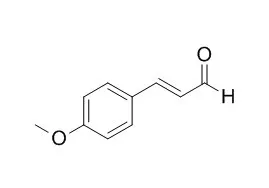| In vitro: |
| Phytomedicine. 2009 Sep;16(9):882-6. | | 4-Methoxycinnamaldehyde inhibited human respiratory syncytial virus in a human larynx carcinoma cell line.[Pubmed: 19303275] |
METHODS AND RESULTS:
4-Methoxycinnamaldehyde, an active constituent of Agastache rugosa, was examined for its cytoprotective activity against RSV by XTT method in human larynx carcinoma cell line. 4-Methoxycinnamaldehyde could effectively inhibit cytopathic effect of RSV (p<0.0001) with an estimated IC(50) of 0.055microg/ml and a selectivity index (SI) of 898.2. 4-Methoxycinnamaldehyde (0.03microg/ml) could inhibit viral entrance by interfering viral attachment (IC(50) of 0.06microg/ml; p<0.0001) and internalization (IC(50) of 0.01microg/ml; p<0.0001). 4-Methoxycinnamaldehyde significantly increased the basal production of IFN (p=0.0015), but not the virus-induced IFN production. Therefore, its cytoprotective activity against RSV was not mediated by interferon.
CONCLUSIONS:
In conclusion, 4-Methoxycinnamaldehyde might be helpful to manage the disease induced by RSV infection. | | J Nematol. 2007 Mar;39(1):31-6. | | Nematicidal Activity of Cassia and Cinnamon Oil Compounds and Related Compounds toward Bursaphelenchus xylophilus (Nematoda: Parasitaphelenchidae).[Pubmed: 19259472 ] |
METHODS AND RESULTS:
The nematicidal activity of two cassia, Cinnamomum cassia, oils (Especial and true), four cinnamon, Cinnamomum zey-lanicum, oils (technical, #500, bark and green leaf), and their compounds (e.g., trans-cinnamaldehyde and trans-cinnamic acid) toward adult Bursaphelenchus xylophilus was examined by a direct contact bioassay. Results were compared with those of 34 related compounds. As judged by 24-hour LC(50) values, two cassia oils (0.084-0.085 mg/ml) and four cinnamon oils (0.064-0.113 mg/ml) were toxic toward adult B. xylophilus. Of 45 test compounds, trans-cinnamaldehyde (0.061 mg/ml) was the most active nematicide, followed by ethyl cinnamate, alpha-methyl-trans-cinnamaldehyde, methyl cinnamate and allyl cinnamate (0.114-0.195 mg/ml). Potent nematicidal activity was also observed with 4-methoxycinnamonitrile, trans-4-Methoxycinnamaldehyde, trans-2-methoxy-cinnamaldehyde, ethyl alpha-cyanocinnamate, cinnamonitrile and cinnamyl bromide (0.224-0.502 mg/ml). Structure-activity relationships indicate that structural characteristics, such as types of functional groups, saturation and carbon skeleton, appear to play a role in determining the toxicities to adult B. xylophilus.
CONCLUSIONS:
Cassia and cinnamon oils and test compounds described merit further study as potential nematicides or leads for the control of pine wilt disease caused by B. xylophilus. |
|






 Cell. 2018 Jan 11;172(1-2):249-261.e12. doi: 10.1016/j.cell.2017.12.019.IF=36.216(2019)
Cell. 2018 Jan 11;172(1-2):249-261.e12. doi: 10.1016/j.cell.2017.12.019.IF=36.216(2019) Cell Metab. 2020 Mar 3;31(3):534-548.e5. doi: 10.1016/j.cmet.2020.01.002.IF=22.415(2019)
Cell Metab. 2020 Mar 3;31(3):534-548.e5. doi: 10.1016/j.cmet.2020.01.002.IF=22.415(2019) Mol Cell. 2017 Nov 16;68(4):673-685.e6. doi: 10.1016/j.molcel.2017.10.022.IF=14.548(2019)
Mol Cell. 2017 Nov 16;68(4):673-685.e6. doi: 10.1016/j.molcel.2017.10.022.IF=14.548(2019)